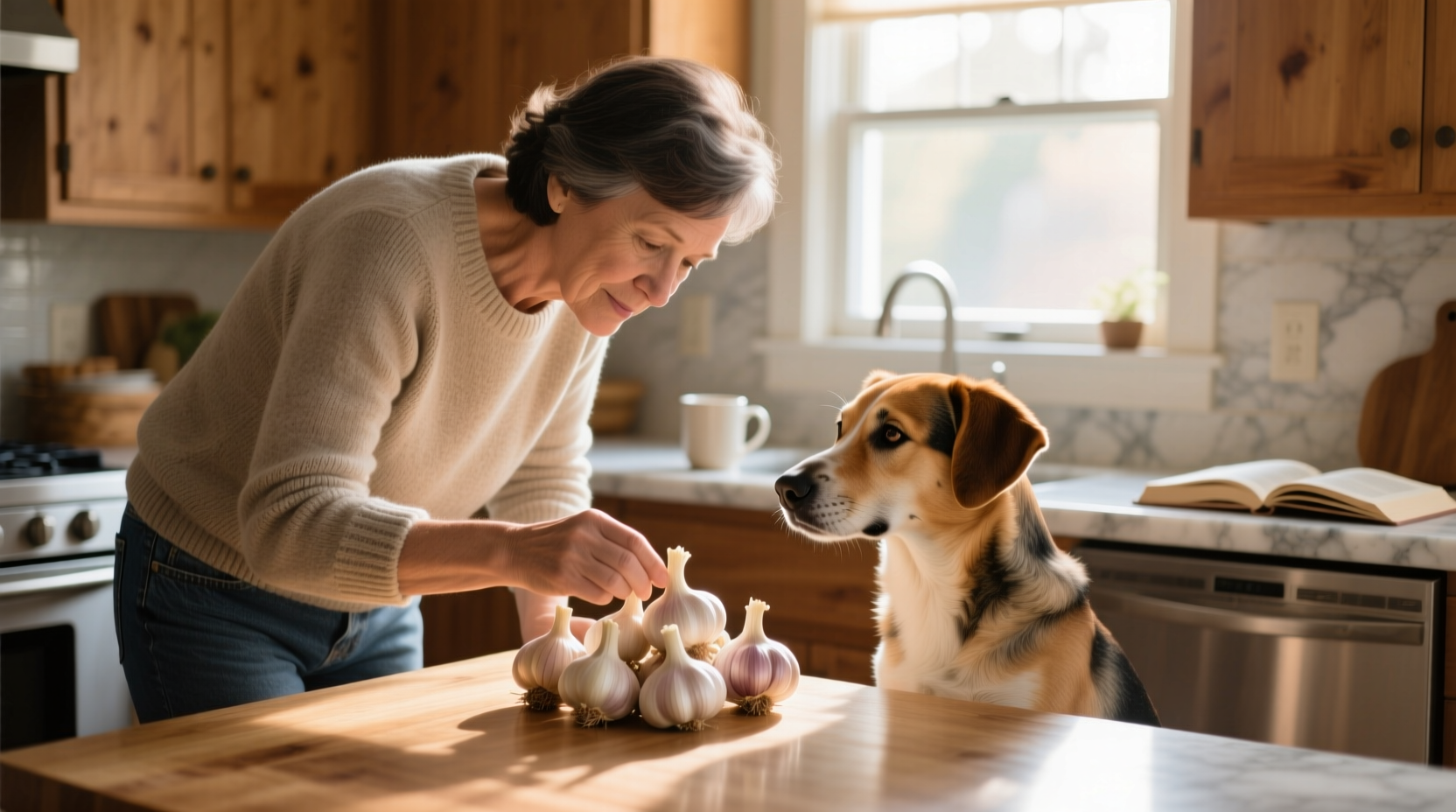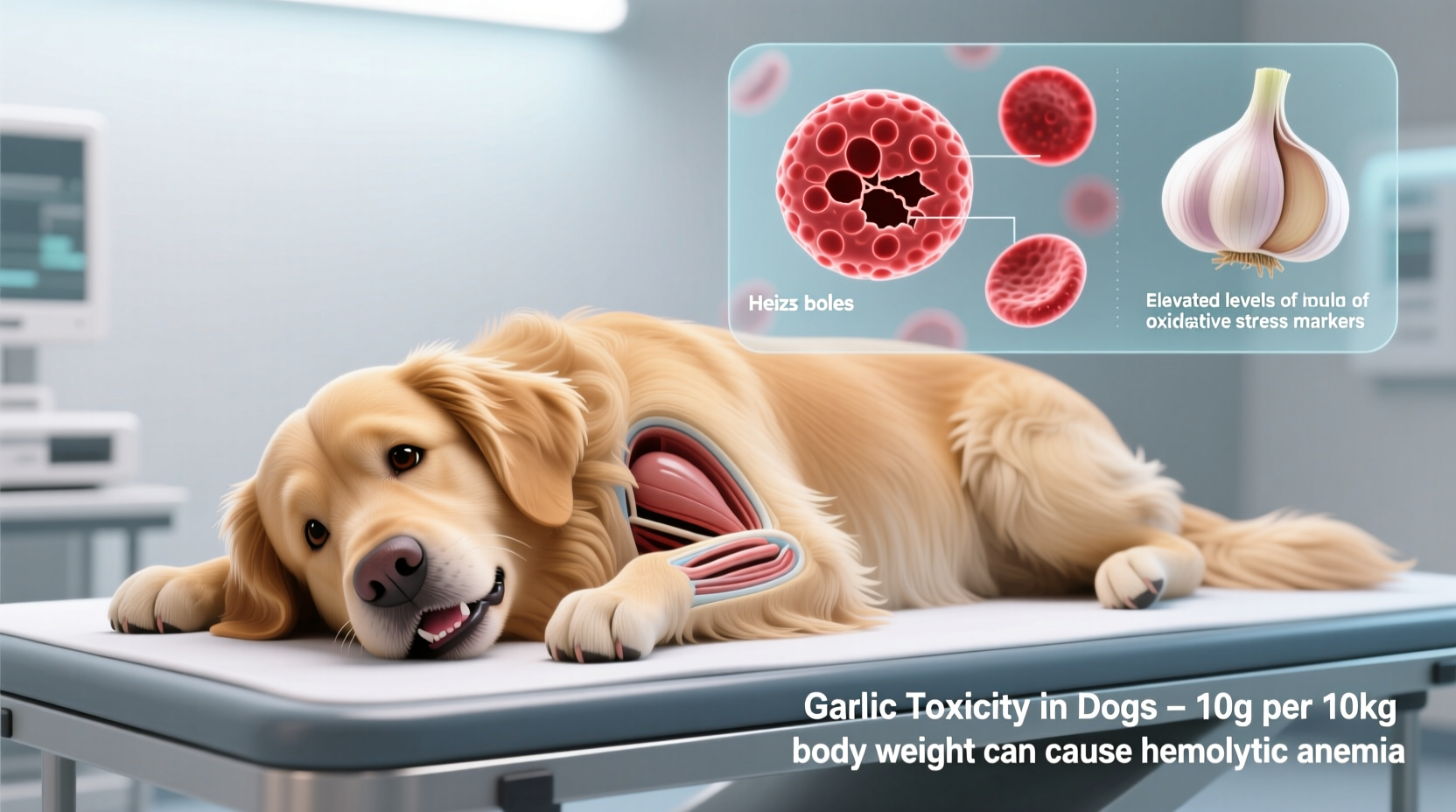Garlic is toxic to dogs and can cause life-threatening hemolytic anemia. Even small amounts can be dangerous, with symptoms appearing 12-48 hours after ingestion. Immediate veterinary care is essential if your dog consumes garlic in any form - raw, cooked, powdered, or in supplements.
As a dog owner, discovering your pet has eaten something potentially harmful triggers immediate panic. Garlic toxicity ranks among the most common yet misunderstood food dangers for canines. Unlike chocolate toxicity which receives widespread attention, garlic poisoning often flies under the radar despite posing serious risks to your dog's health. This comprehensive guide delivers evidence-based information you need to protect your canine companion from this silent threat.
The Science Behind Garlic Toxicity in Dogs
Garlic belongs to the Allium family, which includes onions, chives, and leeks. These plants contain N-propyl disulfide and other sulfur compounds that cause oxidative damage to red blood cells. When dogs ingest garlic, these compounds convert hemoglobin into methemoglobin, which cannot carry oxygen effectively. This triggers hemolysis - the destruction of red blood cells - leading to hemolytic anemia.
Unlike humans who can metabolize these compounds safely, dogs lack sufficient quantities of the enzyme needed to process them. This biological difference makes garlic particularly dangerous for our canine companions. The ASPCA Animal Poison Control Center confirms that all forms of garlic - whether raw, cooked, powdered, or in supplement form - pose risks to dogs.
| Allium Type | Toxic Compound Concentration | Risk Level for Dogs |
|---|---|---|
| Garlic | Highest (5x onion) | Extreme |
| Onion | Moderate | High |
| Chives | High | Very High |
| Leek | Low-Moderate | Moderate |
How Much Garlic Is Dangerous for Dogs?
The toxic dose varies by dog size and individual sensitivity, but veterinary research indicates:
- As little as 15-30 grams of garlic per kilogram of body weight can cause toxic effects
- A single clove of garlic weighs approximately 3-7 grams
- Garlic powder is significantly more concentrated (just 1 teaspoon equals about 1.5 ounces of fresh garlic)
Small breeds face greater risk from smaller quantities. For example, a 10-pound Yorkshire Terrier could experience toxicity from less than one clove of garlic, while a 70-pound Labrador might tolerate slightly more before showing symptoms. However, repeated small exposures can accumulate to dangerous levels over time.

Symptom Timeline: What to Watch For
Garlic toxicity symptoms don't appear immediately, creating a dangerous false sense of security. Understanding this progression timeline helps owners recognize developing problems:
- 0-12 hours: Often no visible symptoms (latency period)
- 12-24 hours: Initial gastrointestinal signs (vomiting, diarrhea, abdominal pain)
- 24-48 hours: Hemolytic anemia symptoms emerge (pale gums, weakness, rapid breathing)
- 48-72 hours: Peak severity with potential collapse, dark urine (hemoglobinuria), jaundice
- 3-7 days: Critical period requiring intensive veterinary intervention
The Merck Veterinary Manual documents cases where dogs developed severe anemia after consuming garlic-containing human foods like pizza, garlic bread, or meat marinades. Many owners don't connect these seemingly minor dietary indiscretions with later-developing health crises.
Immediate Action Plan: Your Dog Ate Garlic
If you witness your dog consuming garlic or suspect recent ingestion, follow these critical steps:
- Contact your veterinarian immediately - Do not wait for symptoms to appear
- Calculate the amount consumed - Note garlic form (fresh, powder, cooked) and quantity
- Do NOT induce vomiting unless specifically instructed by a veterinary professional
- Gather evidence - Bring packaging, food remnants, or photos to the vet
- Monitor closely - Watch for early symptoms while en route to veterinary care
Time is critical with garlic toxicity. The American College of Veterinary Emergency and Critical Care emphasizes that early intervention significantly improves outcomes. Veterinary treatment may include activated charcoal administration, intravenous fluids, oxygen therapy, and in severe cases, blood transfusions.
Common Misconceptions About Garlic and Dogs
Several dangerous myths persist in the pet community:
- "Small amounts are safe or even beneficial" - No scientific evidence supports garlic as a safe supplement for dogs. The purported flea-repelling benefits don't outweigh the risks.
- "Cooked garlic loses toxicity" - Cooking doesn't eliminate the toxic compounds; they remain dangerous in all forms.
- "My dog ate garlic before with no issues" - Toxicity can accumulate with repeated exposure, and individual sensitivity varies.
- "Organic or fresh garlic is safer" - All garlic varieties contain the same toxic compounds regardless of growing method.
The Veterinary Partner resource from the Veterinary Information Network explicitly states that no amount of garlic can be considered completely safe for dogs, debunking popular home remedy recommendations.
Preventing Garlic Exposure: Practical Strategies
Protect your dog with these proactive measures:
- Store garlic and onions securely in closed cabinets away from curious noses
- Dispose of food scraps containing garlic in pet-inaccessible trash containers
- Read pet food and treat labels carefully - some "natural" products contain garlic powder
- Educate family members and visitors about the dangers of sharing human foods
- Avoid using garlic-based flea repellents or home remedies
Be particularly vigilant during holidays when garlic-rich foods like stuffing, roasted meats, and sauces become common. The Pet Poison Helpline reports a 30% increase in garlic toxicity cases during Thanksgiving and Christmas seasons.
When Garlic Might Be Found in Unexpected Places
Dog owners often overlook these common garlic exposure sources:
- Commercial baby food (sometimes used to entice sick dogs to eat)
- "Natural" flea repellent products
- Some homemade broth-based dog treats
- Leftover pizza or pasta dishes
- Garlic-infused oils used in cooking
- Certain commercial dog foods marketed as "holistic" or "natural"
The FDA's Center for Veterinary Medicine has issued warnings about some boutique pet food brands containing potentially harmful levels of garlic derivatives. Always research ingredients thoroughly before selecting dog food.











 浙公网安备
33010002000092号
浙公网安备
33010002000092号 浙B2-20120091-4
浙B2-20120091-4